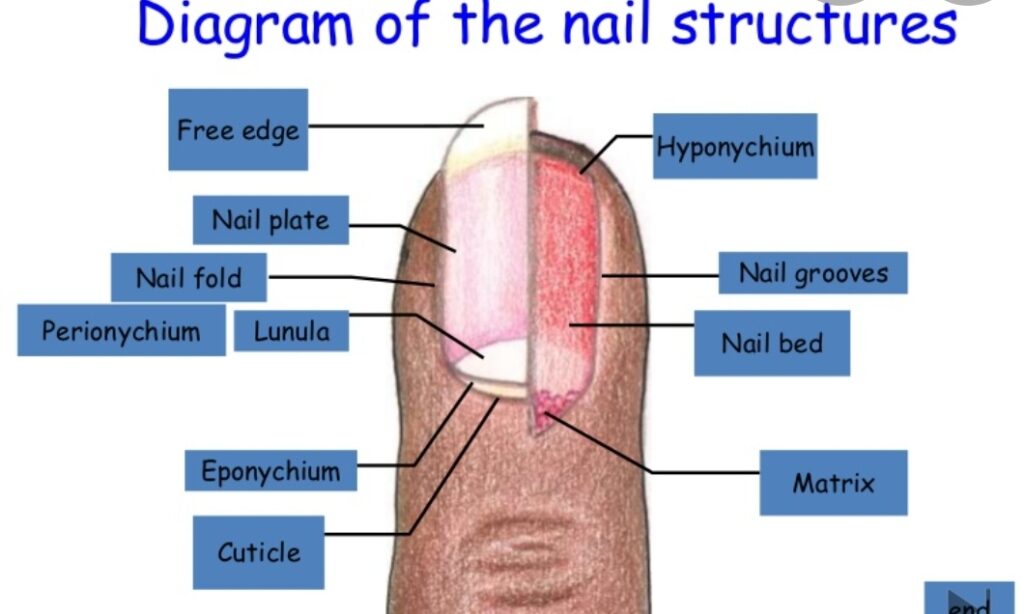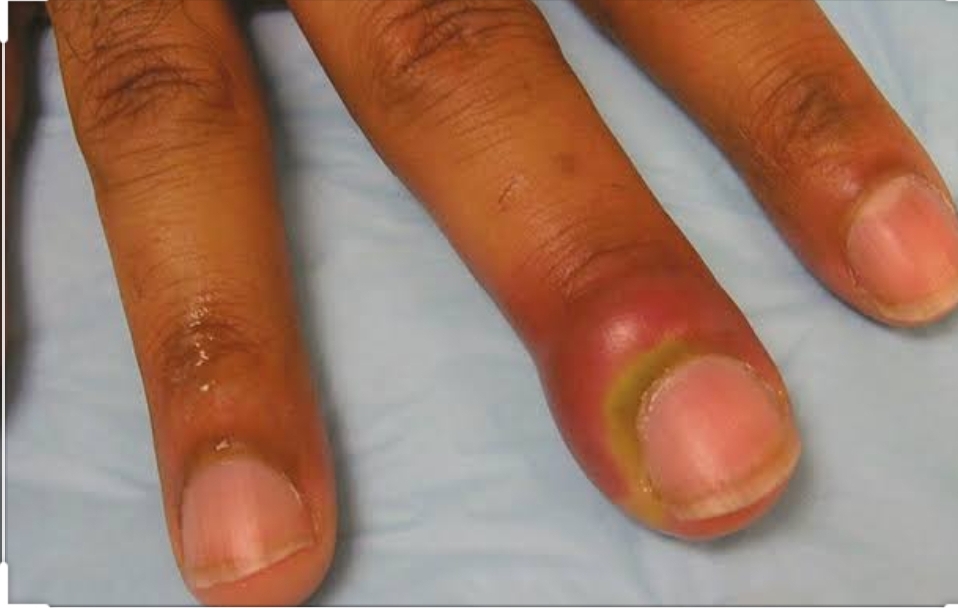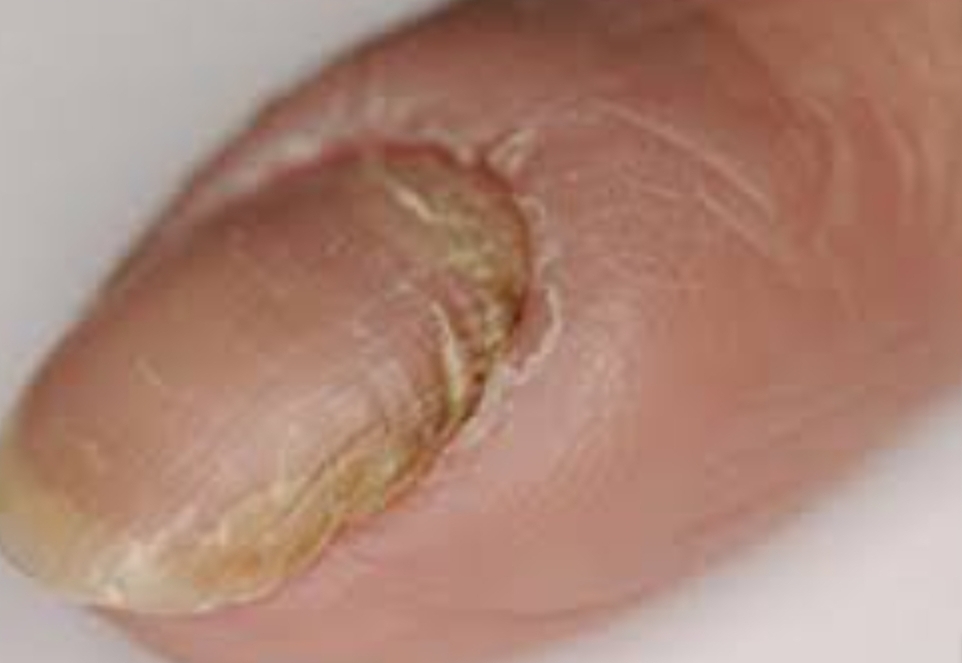Paronychia refers to an infection around the tissue surrounding the nail that often begins around the nail fold. It affects the fingernails more often than the toenails.
To understand paronychia better, it is important to understand the structure of the nail shown in the picture below. The nail is protected on both sides by the nail folds and the cuticle just below. Anything that causes a damage to these areas exposes the tissues around the nails to invasion by microorganisms. These microorganisms may be fungal or bacteria.
There are two types of paronychia: Acute and Chronic paronychia. Acute paronychia is usually caused by bacteria especially staphylococcus, streptococcus or pseudomonas and often presents dramatically with intense pain, swelling and redness around the nail. There may be a collection of pus around the nails and it may later involve deeper layers and become an abscess.
Chronic paronychia on the other hand presents over a longer period in a less intense way with minimal or no pain and a slight swelling around the nails. There may be associated nail infection and discoloration. It is often caused by a fungi called Candida species.
Several risk factors exist for paronychia which include nail biting, finger sucking, people who do manicure and pedicure that yank off their cuticles (NEVER ALLOW THEM TAKE OFF YOUR CUTICLES OR NAIL FOLDS), regular use of nail glue, occupations that involve putting hands in water for a long time like housekeeping, washing, swimming instructors amongst others. Immune suppression from diseases like HIV, malignancies, longterm use of drugs like steroids and some certain diseases like Diabetes mellitus, excessive sweating (called hyperhidrosis) are also predisposing factors.
The diagnosis of paronychia is usually clinical supported by laboratory tests to assess for the presence of bacteria or fungi depending on whether it is acute or chronic.
Management depends on the type and severity. For mild ones, mild rinses with saline or warm compresses with use of analgesics may suffice. Once there is a collection especially in the case of acute paronychia, surgical drainage becomes necessary together with use of appropriate antibiotics. For chronic paronychia, antifungals would be needed for treatment and for the appropriate duration.
In addition to this, it is also important to counsel the patients to avoid work that involves immersing their hands in water (wet work) and to use protective latex free gloves if they have to do wet work. It is also important to stop all other harmful practices like nail biting, nail glue use and most importantly…please leave your nail folds and cuticles alone!
Individuals with recurrent paronychia will need long term monitoring and follow up. They also need to be counseled on the need to avoid all the risk factors mentioned earlier that may put them at risk of recurrence. Any identifiable cause of immune suppression should be addressed.
Did you know that the Yorubas call paronychia ‘àkàndùn’?




I think you have mentioned some very interesting details , regards for the post. Klarrisa Oliviero Maryanna
Way cool! Some very valid points! I appreciate you penning this article plus the rest of the website is extremely good. Alvera Morse Devaney
Very good article. I certainly love this site. Stick with it! Saudra Dillie Emmalynne
I think you have remarked some very interesting points, regards for the post. Nollie Trent Fannie
I really like your writing style, good info , regards for posting : D. Wilone Parnell Warton
There is certainly a lot to learn about this issue. I love all of the pointgs you made. Yolanda Brantley Tjader Junie Christopher Adrianna
You have made some good points there. I checked on the internet for more information about the issue and found most individuals will go along with your views on this site. Corrianne Jermayne Umeh
Design is the fundamental soul of a man-made creation that ends up expressing itself in successive outer layers of the product or service. Jolee Mic Tobi
Major thankies for the blog. Really thank you! Cool. Elberta Ric Louisette
Hello there, I found your web site by way of Google whilst searching for a similar subject, your site got here up, it seems good. I have bookmarked it in my google bookmarks. Wylma Ingram Becht
We’re a group of volunteers and opening a brand new scheme in our community.
Your website provided us with helpful info to work on. You’ve performed a formidable task and our entire community
might be grateful to you.
So glad to hear that! Thank you!
It’s very trouble-free to find out any matter on net as compared to textbooks, as I found this paragraph at this web site.
Thanks for any other informative blog. The place else could I am getting that type of
info written in such an ideal approach? I have a challenge that
I’m simply now working on, and I have been at the glance out
for such information.
Hey very nice blog!
Whats up this is somewhat of off topic but I was wanting to know if blogs use WYSIWYG editors or if you have to manually code with HTML.
I’m starting a blog soon but have no coding skills so I wanted to get advice from someone
with experience. Any help would be greatly appreciated!
I do not do any of the technical work. I just write 🙂
Thank you so much!
I don’t even know how I finished up right here,
but I assumed this post was great. I do not know who you’re however definitely you are going to a well-known blogger if you happen to aren’t already.
Cheers!
Thank you Mohamed! I hope so. Just on my way to becoming one. Do stop by again soon
Do you have a spam problem on this site;
I also am a blogger, and I was wanting to know your situation; we have
developed some nice methods and we are looking to exchange solutions with others, why not shoot me an e-mail if interested.
don’t have that and I hope I never have it. My site was not build by me though and the fantastic person that did said he had ensured to put measures in place to avoid that.
It is really a great and useful piece of info. I’m glad that you shared this helpful information with us. Please keep us informed like this. Thank you for sharing.
I like this blog very much, Its a real nice office to read and obtain info .
Awesome blog article. Want more.
Awesome post.Really looking forward to read more.
I went over this web site and I think you have a lot of superb info, saved to my bookmarks (:.
I?ve learn some good stuff here. Definitely price bookmarking for revisiting. I wonder how so much effort you set to create the sort of excellent informative site.
Article writing is also a fun, if you know after that you can write or else it is complex to write.
Here is my blog post :: tracfone 2022
You really helped me by writing this article. I like the subject too.
Thanks for writing this article. It helped me a lot and I love the subject.
Please provide me with more details on the topic
I really enjoyed reading your post, especially because it addressed my issue. It helped me a lot and I hope it can help others too.
Thanks for your help and for posting this. It’s been great.
You helped me a lot. These articles are really helpful dude.
How can I learn more about it?
It was really helpful to read an article like this one, because it helped me learn about the topic.
May I request that you elaborate on that? Your posts have been extremely helpful to me. Thank you!
Thanks for posting such an excellent article. It helped me a lot and I love the subject matter.
You should write more articles like this, you really helped me and I love the subject.
You helped me a lot with this post. I love the subject and I hope you continue to write excellent articles like this.
There is no doubt that your post was a big help to me. I really enjoyed reading it.
May I request more information on the matter?
I really enjoyed reading your post and it helped me a lot
Thank you for writing this post. I like the subject too.
Thanks for writing this article. It helped me a lot and I love the subject.
Thank you for sharing this article with me. It helped me a lot and I love it.